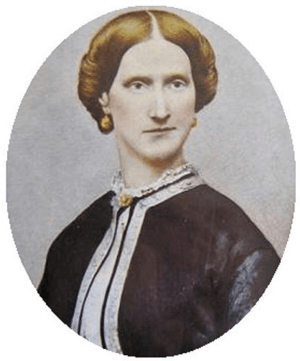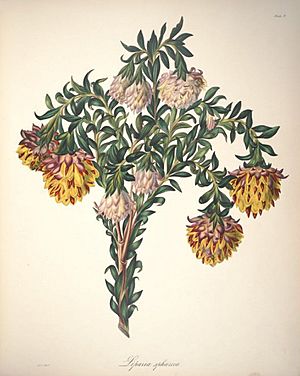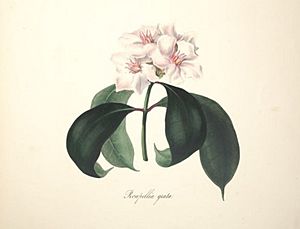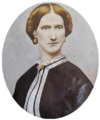Arabella Elizabeth Roupell facts for kids
Quick facts for kids
Arabella Elizabeth Roupell
|
|
|---|---|
 |
|
| Born | 23 March 1817 Newport, Shropshire
|
| Died | 31 July 1914 (aged 97) Swallowfield
|
| Nationality | British |
| Known for | flower painter |
Arabella Elizabeth Roupell (born March 23, 1817, in Newport, Shropshire; died July 31, 1914, in Swallowfield, Berkshire) was a talented English artist. She was famous for painting beautiful flowers. In 1849, a collection of her flower paintings was published. It was called 'Specimens of the flora of South Africa by a Lady'. At first, her name was not on the book.
Contents
Early Life and Adventure
Arabella was the daughter of Rev. John Dryden Piggott. He was a rector and squire in Edgmond. On September 16, 1840, she married Thomas Boone Roupell. He worked for the East India Company.
In 1843, Arabella and Thomas had their first son. Soon after, Thomas was sent to the Cape Colony (modern-day South Africa). Arabella decided to go with him. This was a big adventure for her.
Painting Flowers in South Africa
During her two years in South Africa, Arabella painted many local flowers. She loved capturing their beauty. A visitor named Nathaniel Wallich saw her work. He was in charge of the Calcutta Botanical Garden. Wallich was very impressed by her paintings.
Wallich often joined Arabella on trips to find new flowers. He also introduced her to his friends. These included Thomas Maclear, the Cape Astronomer Royal, and his wife Mary. Arabella became good friends with Mary. She also met Baron von Ludwig, who helped create the Botanical Garden in Cape Town. Another friend was James Bowie, a plant collector for Kew Gardens.
Sharing Her Art with the World
In 1845, the Roupells moved to Madras in India. Arabella continued to paint plants there. In 1846, Nathaniel Wallich retired and moved to London. He convinced Arabella to let him take some of her paintings. He wanted to show them to Sir William Jackson Hooker. Hooker was a very important botanist.
Hooker loved Arabella's artwork. He and Arabella's brother-in-law, George Roupell, chose ten paintings to be published. A famous artist named Paul Gauci then made prints of the paintings. William Henry Harvey, an Irish botanist, wrote the descriptions for the book.
The book was called 'Specimens of the flora of South Africa by a Lady'. It was very popular. Even Queen Victoria and Prince Albert were among the subscribers. The book was praised in England and Europe. Arabella was even made a member of the Regensburg Society of Arts. Only about 110 copies were printed. This makes the book very rare and special today.
Life After Painting
The East India Company closed down in 1858. After this, the Roupells retired to Loddar Court near Reading, Berkshire. Thomas had been promoted to a judge in India. This meant the family was financially secure.
Arabella then focused on landscape gardening. She also spent part of each year at Sundorne Castle. This was her father's family home in Shropshire.
Rediscovering Her Lost Art
Many of Arabella's paintings were not published in her first book. About a hundred of these were found in the 1930s. They were with George Roupell, Arabella's grandson. For a long time, no one could get him to share them.
Then, something surprising happened. A package arrived for General Jan Smuts in South Africa. This was during his final illness. The package was not opened until after Smuts died in 1950. It was then given to Illtyd Buller Pole-Evans. He recognized the paintings as the missing collection.
Pole-Evans gave the paintings to Mary Gunn. She was a librarian at the Botanical Research Institute. Mary immediately knew how important they were. The paintings were shown at an exhibition in Johannesburg in 1951. After that, the Smuts family gave them to the University of Cape Town. They are now kept at the Bolus Herbarium library.
Some of these newly found paintings were published later. In 1964, eleven plates were published as 'More Cape Flowers by a Lady'. In 1975, more paintings and information about Arabella were published in a book called 'Arabella Roupell'. Another painting of a Cape Erica flower is now at the Museum Africa in Johannesburg.
Legacy
Arabella Roupell is remembered for her beautiful flower paintings. A plant called Protea roupelliae was named after her. This was done by the Swiss botanist Carl Meissner. Another plant, Roupellia grata, was also named to honor her family. It is now known as Strophanthus gratus.
Images for kids
See also
 In Spanish: Arabella Elizabeth Roupell para niños
In Spanish: Arabella Elizabeth Roupell para niños




